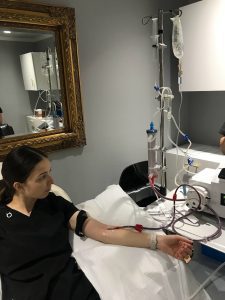Revitalize and Rejuvenate: Unlocking the Power of Extracorporeal Blood Oxygenation and Ozonation Therapy
In the quest for optimal health and vitality, the utilization of cutting-edge therapies has emerged as a beacon of hope for many individuals seeking alternative approaches to wellness. Among these innovative treatments, extracorporeal blood oxygenation and ozonation therapy stands out as a promising technique that harnesses the power of oxygen and ozone to revitalize the body at a cellular level.
Extracorporeal blood oxygenation and ozonation therapy, often referred to as EBOO therapy, involves the process of enriching the blood with additional oxygen and ozone outside the body before reintroducing it back into the circulatory system. This approach facilitates enhanced oxygen delivery to tissues and organs, leading to a cascade of benefits such as improved cellular function, enhanced immune response, and overall rejuvenation of the body. The synergistic effects of oxygen and ozone not only help optimize metabolic processes but also support detoxification and promote systemic balance. As we delve deeper into the realm of holistic well-being, it's essential to explore the transformative potential of EBOO therapy in unlocking the body's innate capacity for healing and renewal.

Benefits of Extracorporeal Blood Oxygenation and Ozonation Therapy
Incorporating extracorporeal blood oxygenation therapy into treatment plans has shown remarkable effectiveness in improving oxygen levels in the blood stream, promoting enhanced organ function, and speeding up the body's natural healing processes. eboo therapy benefits in the removal of toxins and metabolic waste products from the bloodstream, providing a detoxifying effect on the body's overall system.
Furthermore, the combination of blood oxygenation and ozonation therapy has demonstrated significant potential in bolstering the immune system's response by increasing the level of oxygen in the body. This heightened oxygenation plays a crucial role in fortifying the immune system, enabling it to more effectively combat infections, inflammation, and various illnesses. As a result, individuals undergoing this therapy often experience reduced recovery times from common ailments and improved overall health.
Additionally, extracorporeal ozonation therapy has been linked to enhanced circulation and blood flow throughout the body. By introducing ozone into the bloodstream, this therapy can help improve the delivery of oxygen and nutrients to tissues and organs, contributing to increased energy levels, mental clarity, and overall vitality. The revitalizing effects of this therapy have been reported by many individuals, who attest to feeling more energized and rejuvenated after undergoing sessions.
Applications in Medical Treatments
In the field of medical treatments, extracorporeal blood oxygenation therapy has shown promising results in conditions such as acute respiratory distress syndrome (ARDS) and carbon monoxide poisoning. By enriching the blood with oxygen outside the body, this therapy provides vital support to the lungs and helps improve oxygenation levels in the bloodstream.
Furthermore, extracorporeal ozonation therapy has been utilized in the treatment of chronic infections and inflammatory conditions. By introducing ozone into the blood, this therapy can help enhance the body's immune response, reduce inflammation, and combat pathogenic microorganisms. This innovative approach holds potential in managing conditions where conventional treatments may have limited efficacy.
Combining the benefits of both blood oxygenation and ozonation therapies, medical professionals are exploring dual therapy approaches for conditions such as sepsis and certain autoimmune disorders. By synergistically harnessing the power of oxygenation and ozonation, these dual therapies aim to optimize treatment outcomes and provide new avenues for improving patient health and well-being.
Future Implications and Research Directions
In the future, continued research into extracorporeal blood oxygenation and ozonation therapy is crucial to explore its full potential. This could involve investigating new applications of the therapy for different medical conditions and diseases. Additionally, research should focus on optimizing the techniques and protocols used to enhance the efficacy and safety of the treatment.
Moreover, exploring the long-term effects of extracorporeal blood oxygenation and ozonation therapy on patients is essential. Longitudinal studies can provide valuable insights into the sustained benefits and potential risks associated with the treatment over an extended period. Understanding how the therapy interacts with the body over time will be key in developing guidelines for its use in clinical settings.
Furthermore, collaboration between researchers, clinicians, and industry partners is essential to drive innovation in extracorporeal blood oxygenation and ozonation therapy. By working together, we can accelerate the development of new technologies, protocols, and treatment approaches. This collective effort can lead to groundbreaking advancements in the field, ultimately benefiting patients worldwide.